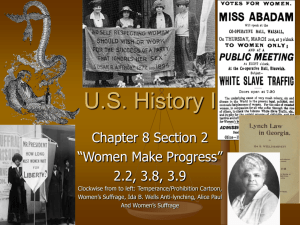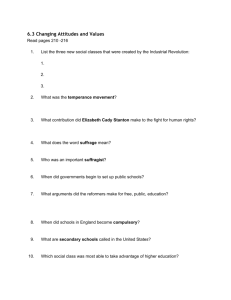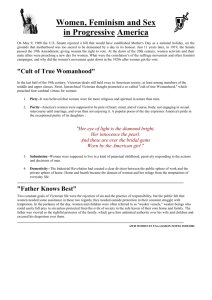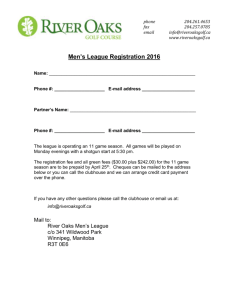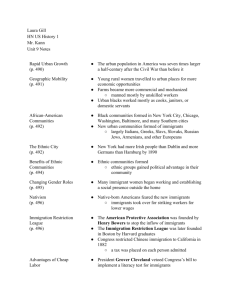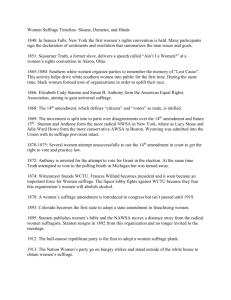TERMS AND FIGURES TO COME TO TERMS WITH FOR THE
advertisement
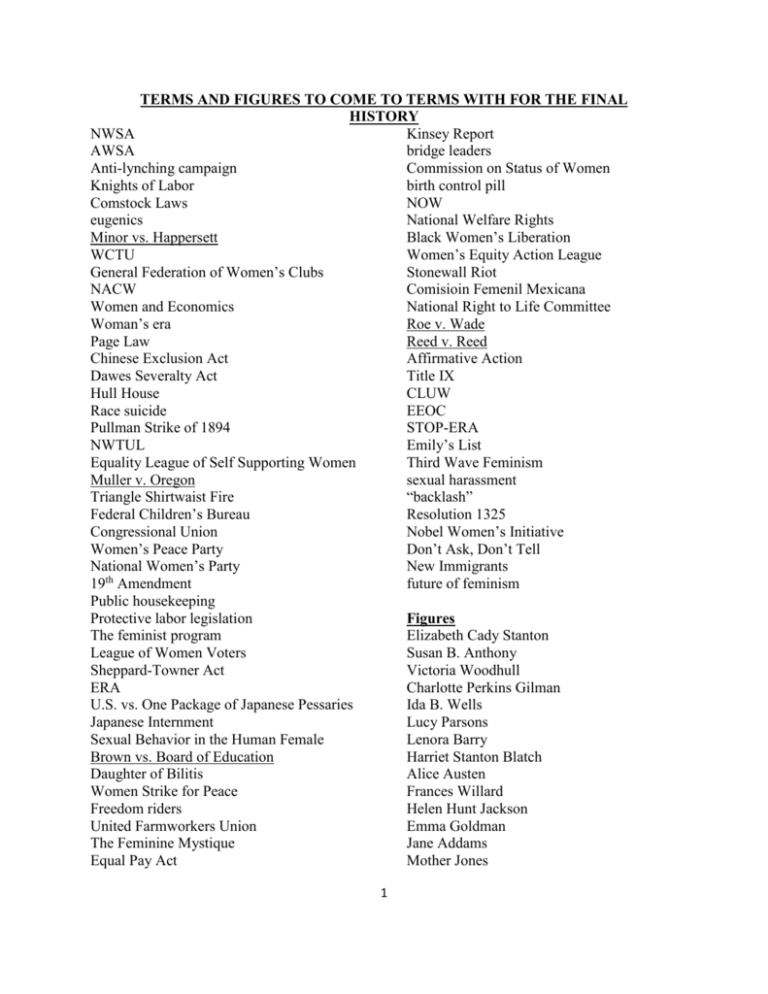
TERMS AND FIGURES TO COME TO TERMS WITH FOR THE FINAL HISTORY NWSA Kinsey Report AWSA bridge leaders Anti-lynching campaign Commission on Status of Women Knights of Labor birth control pill Comstock Laws NOW eugenics National Welfare Rights Minor vs. Happersett Black Women’s Liberation WCTU Women’s Equity Action League General Federation of Women’s Clubs Stonewall Riot NACW Comisioin Femenil Mexicana Women and Economics National Right to Life Committee Woman’s era Roe v. Wade Page Law Reed v. Reed Chinese Exclusion Act Affirmative Action Dawes Severalty Act Title IX Hull House CLUW Race suicide EEOC Pullman Strike of 1894 STOP-ERA NWTUL Emily’s List Equality League of Self Supporting Women Third Wave Feminism Muller v. Oregon sexual harassment Triangle Shirtwaist Fire “backlash” Federal Children’s Bureau Resolution 1325 Congressional Union Nobel Women’s Initiative Women’s Peace Party Don’t Ask, Don’t Tell National Women’s Party New Immigrants th 19 Amendment future of feminism Public housekeeping Protective labor legislation Figures The feminist program Elizabeth Cady Stanton League of Women Voters Susan B. Anthony Sheppard-Towner Act Victoria Woodhull ERA Charlotte Perkins Gilman U.S. vs. One Package of Japanese Pessaries Ida B. Wells Japanese Internment Lucy Parsons Sexual Behavior in the Human Female Lenora Barry Brown vs. Board of Education Harriet Stanton Blatch Daughter of Bilitis Alice Austen Women Strike for Peace Frances Willard Freedom riders Helen Hunt Jackson United Farmworkers Union Emma Goldman The Feminine Mystique Jane Addams Equal Pay Act Mother Jones 1 Florence Kelley Alice Paul Margaret Sanger Nannie Burroughs Ellen Woodward Mary Van Kleeck Frances Perkins Helen Douglas Ella Baker Rachel Carson Dolores Huerta Fannie Lou Hamer Mary King Kate Millet Angela Davis Gloria Steinem Clemencia Lopez Lucy Burns Mary Beard Clara Bow Mary Bethune Lucienne Bloch Rosie the Riveter Rosa Parks Diane Nash Frances Kelsey Betty Friedan Casey Hayden Eleanor Roosevelt Shirley Chisholm Phyllis Schlafly Sandra Day O’Connor STUDY QUESTIONS FOR THE MIDTERM 1. Describe how the woman’s suffrage movement respond to the congressional debates over the Fourteenth and Fifteenth Amendments? 2. In 1871, how did Victoria Claflin Woodhull present the case for the New Departure? 3. Describe the Supreme Court’s decision in Minor v. Happersett 4. Describe how many freedwomen responded to the defeat of the Confederacy. 5. What was the relationship of black women to the new all-black universities established after the Civil War? 6. Explain why office work become the fastest-growing sector of the female labor force by 1900? 7. How did the Knights of Labor and the American Federation of Labor (AFL) treat working women in the late 1800s? 8. Describe the expected role for women in the growing number of wealthy American families after the Civil War. 9. Describe how elite white women affected by Reconstruction? 10. What was the danger that African American men faced in the Reconstructed South for the slightest suspicion of disrespect to a white woman? 11. Write Ida B. Wells into U.S. history. 12. What was Harriot Stanton Blatch encouraging women to do when she advocated “voluntary motherhood”? 13. What did the term “New Woman” mean in terms of women’s work? 14. How did the Dawes Severalty Act affect Native women? 15. What was a difference between farm women’s experiences in the West from that of their life in the East? 16. What was the distinctive reason that young women immigrants had for moving to the United States in the late nineteenth century? 17. Explain why immigrants sent their teenage daughter into the workforce and what was the result? 2 18. Write Emma Goldman into U.S. history. 19. How did the lives of Hispanic women differ from those of white women living in the West in the late 1800s? 20. Describe the obstacles immigrant women faced on their journey to the United States? 21. Why was legislation passed in 1875 to discourage the immigration of Chinese women? 22. What role did women play during the Pullman strike of 1894? 23. Write Florence Kelley into U.S. history. 24. What was a result of the practice among immigrants of sending teenage daughters into the American labor force? 25. How did clerical work change as more women moved into the occupation? 26. Describe the goals of the Women’s Trade Union League (WTUL)? 27. What was a central principle of “Maternalism,” a term coined by recent historians to refer to the Progressive-era justification for women’s programs? 28. Describe the Supreme Court’s decision in Muller v. Oregon (1908). 29. How did a new generation of suffrage leaders try to bring the suffrage movement into conformity with the realities of urban, industrial, modern America in the early 1900s? 30. Why did female progressives fail to end child labor? 31. Write Ida B. Wells-Barnett into U.S. history. 32. What did the disparity in average working men’s and women’s wages reflect in 1900? 33. Describe the idea of public housekeeping and how it impact the public sector. 34. Explain why the power of the maternalism was not successful in child protective labor legislation. 35. Explain why it too so long to win the vote for women. 36. In 1920, white women formed the League of Women Voters for what purpose? 37. Write Dorothea Lange’s photograph, “Migrant Mother,” into U.S. history. 38. How did the Depression affect jobs for African American women? 39. Describe women’s role during World War II. 40. How did some white women respond to the employment of African American women in the defense industries? 41. Describe what the National Woman’s Party (NWP) focused on after the woman suffrage amendment was ratified? 42. What did the organization Daughters of Bilitis defend? 43. What was Betty Friedan referring to when she wrote about “the problem that has no name” in her best-selling book The Feminine Mystique? 44. What did the Supreme Court rule in the landmark Supreme Court case Brown v. Board of Education of Topeka (1954)? 45. Describe one legacy of the President’s Commission on the Status of Women. 46. Describe the type of revolutionary change the women’s liberation movement sought. 47. Describe the changes in higher education for women as a result of the women’s liberation movement. 48. Write Sandra O’Connor into U.S. history. 49. What is one idea you have for change in the future for young women. 50. Write yourself into U.S. history. 3
